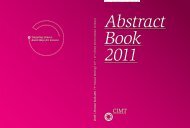Abstract Book 2010 - CIMT Annual Meeting
Abstract Book 2010 - CIMT Annual Meeting
Abstract Book 2010 - CIMT Annual Meeting
Create successful ePaper yourself
Turn your PDF publications into a flip-book with our unique Google optimized e-Paper software.
066 Dettmar | New targets & new leads<br />
Identification of clinically useful combinations of trifunctional<br />
antibodies with chemotherapy using different preclinical<br />
models<br />
Kirsten Dettmar 1 , Petra Schroeder 2 , Carsten Lindemann 2 , Andrea Eberhardt 1 , Franziska<br />
Hirschhaeuser 3 , Diane Seimetz 1 , Judith Atz 1<br />
1 Fresenius Biotech GmbH, Munich, Germany<br />
2 EUFETS GmbH, Idar-Oberstein, Germany<br />
3 Institute of Physiology and Pathophysiology, University Medical Center of the Johannes Gutenberg-University<br />
Mainz, Germany<br />
The trifunctional bispecific antibodies catumaxo-<br />
mab (anti-EpCAM x anti-CD3) and ertumaxomab<br />
(anti-HER-2/neu x anti-CD3) exert their mechanism<br />
of action by simultaneous recruitment and activation<br />
of two different types of immune effector cells<br />
(T-cells and accessory cells) at the tumor site. Thus<br />
tumor cells and immune effector cells are brought<br />
into close proximity leading to physiological co-stimulation<br />
of T-cells, improved tumor cell elimination<br />
by different immunologic killing mechanisms<br />
and phagocytosis, as well as processing and presentation<br />
of tumor material by bound and activated<br />
accessory cells.<br />
Despite the development of different antibody therapies,<br />
chemotherapy (CTX) still represents the mainstay<br />
of cancer therapy. Therefore many antibodies<br />
are either used in combination with the established<br />
chemotherapeutic therapies or in short intervals afterwards.<br />
However, the commonly observed hematological<br />
toxicities of chemotherapeutics are regularly associated<br />
with some degree of immunosuppression.<br />
On the other hand, some of these chemotherapeutic<br />
agents are reported to support or even enhance the<br />
anti-tumor effect of immunotherapeutic drugs in<br />
certain doses.<br />
A largely intact immune system is the key for trifunctional<br />
antibodies to exhibit their full mode of action.<br />
Since chemotherapy might impact the number and<br />
/ or function of immune effector cells, we evaluated<br />
in different preclinical in vitro models whether the<br />
efficacy of trifunctional bispecific antibodies would<br />
be influenced when combined with chemotherapeutic<br />
drugs from different drug classes.<br />
The preclinical studies performed included in vitro<br />
cytotoxicity assays with established tumor cell lines<br />
evaluating potential synergy by using the method<br />
of Chou and Talalay. Furthermore, results from 3D<br />
tumor spheroids and from an autologous human<br />
ex vivo setting are presented. In addition, immune<br />
cells from cancer patients were obtained at different<br />
time points before, during and after chemotherapy<br />
and were assessed for their in vitro cytotoxicity mediated<br />
by trifunctional antibodies.<br />
So far the results from the different in vitro assay<br />
systems used indicate synergy for the combination<br />
of the trifunctional antibodies with 5-Fluorouracil<br />
(5-FU), cisplatin and epirubicin. Furthermore, no<br />
negative influence of these chemotherapeutic drugs<br />
was observed on the trifunctional mode of action<br />
in vitro. Catumaxomab and ertumaxomab were<br />
able to mediate an effective killing of tumor cells<br />
with immune cells from chemotherapy patients<br />
shortly after chemotherapy. The respective patients<br />
immune cells can be activated by these bispecific<br />
antibodies one week after chemotherapy with pyrimidine<br />
antagonists (5-FU) and alkylating agents<br />
(cisplatin) resulting in significant tumor cell killing<br />
in vitro.<br />
These results provide a basis for the possible combination<br />
of these drugs with trifunctional antibodies<br />
in the clinical setting.<br />
111



